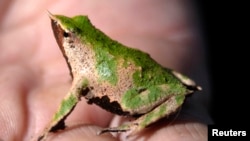LONDON —
A frog named after Charles Darwin has gone extinct because of a deadly amphibian skin disease, scientists believe.
Darwin's frogs were named after the father of evolution, who discovered them in 1834 in Chile during his voyage around the world on the ship HMS Beagle.
They are notable for having evolved to escape predators by looking like a dead leaf, with a pointy nose, and the fact that the males carry young tadpoles around inside their vocal sacs.
Researchers think the northern Darwin's frog, one of two species, has been killed off completely by a fungal disease called chytridiomycosis that infects their skin. Numbers of the related southern species have plunged dramatically.
An analysis into the spread of the disease by a team from the Zoological Society of London (ZSL) and Chile's Universidad Andres Bello found that habitat loss contributed to the decline, but this alone could not explain the animal's demise.
“Only a few examples of the 'extinction by infection' phenomenon exist,” said Andrew Cunningham, from ZSL's Institute of Zoology.
“Although not entirely conclusive, the possibility of chytridiomycosis being associated with the extinction of the northern Darwin's frog gains further support with this study.”
The scientists' findings were published online on Wednesday in the journal PLOS ONE.
Darwin's frogs were named after the father of evolution, who discovered them in 1834 in Chile during his voyage around the world on the ship HMS Beagle.
They are notable for having evolved to escape predators by looking like a dead leaf, with a pointy nose, and the fact that the males carry young tadpoles around inside their vocal sacs.
Researchers think the northern Darwin's frog, one of two species, has been killed off completely by a fungal disease called chytridiomycosis that infects their skin. Numbers of the related southern species have plunged dramatically.
An analysis into the spread of the disease by a team from the Zoological Society of London (ZSL) and Chile's Universidad Andres Bello found that habitat loss contributed to the decline, but this alone could not explain the animal's demise.
“Only a few examples of the 'extinction by infection' phenomenon exist,” said Andrew Cunningham, from ZSL's Institute of Zoology.
“Although not entirely conclusive, the possibility of chytridiomycosis being associated with the extinction of the northern Darwin's frog gains further support with this study.”
The scientists' findings were published online on Wednesday in the journal PLOS ONE.






